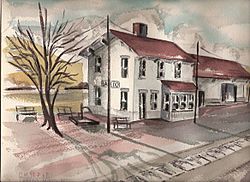Laredo, Missouri facts for kids
Quick facts for kids
Laredo, Missouri
|
|
|---|---|

The former Milwaukee Railroad depot in Laredo. Watercolor by R.L. Huffstutter.
|
|

Location of Laredo, Missouri
|
|
| Country | United States |
| State | Missouri |
| County | Grundy |
| Area | |
| • Total | 0.28 sq mi (0.71 km2) |
| • Land | 0.28 sq mi (0.71 km2) |
| • Water | 0.00 sq mi (0.00 km2) |
| Elevation | 814 ft (248 m) |
| Population
(2020)
|
|
| • Total | 156 |
| • Density | 567.27/sq mi (218.90/km2) |
| Time zone | UTC-6 (Central (CST)) |
| • Summer (DST) | UTC-5 (CDT) |
| ZIP code |
64652
|
| Area code(s) | 660 |
| FIPS code | 29-40736 |
| GNIS feature ID | 2395634 |
Laredo is a small city located in Grundy County, Missouri, in the United States. In 2020, about 156 people lived there. The name Laredo is pronounced "la-read-oh," which is a bit different from how you might expect.
Contents
Geography of Laredo
Laredo is found where two Missouri roads, Route E and Route V, meet. It is about eight miles southeast of Trenton. A stream called Medicine Creek flows along the east side of the city.
The United States Census Bureau says that Laredo covers a total area of about 0.28 square miles (0.71 square kilometers). All of this area is land.
People Living in Laredo
Laredo's population has changed over many years. Here's how many people have lived there during different census counts:
| Historical population | |||
|---|---|---|---|
| Census | Pop. | %± | |
| 1900 | 286 | — | |
| 1910 | 758 | 165.0% | |
| 1920 | 728 | −4.0% | |
| 1930 | 578 | −20.6% | |
| 1940 | 1,421 | 145.8% | |
| 1950 | 426 | −70.0% | |
| 1960 | 370 | −13.1% | |
| 1970 | 383 | 3.5% | |
| 1980 | 340 | −11.2% | |
| 1990 | 205 | −39.7% | |
| 2000 | 250 | 22.0% | |
| 2010 | 198 | −20.8% | |
| 2020 | 156 | −21.2% | |
| U.S. Decennial Census | |||
Laredo's Population in 2010
In 2010, the census showed that 198 people lived in Laredo. There were 89 households and 59 families. The city had about 707 people per square mile.
Most people living in Laredo in 2010 were White (99.5%). A small number (0.5%) were from two or more racial backgrounds.
About 24.7% of households had children under 18 living with them. Many households (53.9%) were married couples. About 28.1% of all households were made up of people living alone.
The average age of people in Laredo in 2010 was 47.5 years old. About 16.2% of residents were under 18. About 23.2% were 65 years old or older. The city had slightly more females (51.0%) than males (49.0%).
Famous People from Laredo
Some notable people have come from Laredo, Missouri:
- Rex Barnett (born 1938) was a politician. He also used to be an officer for the Missouri State Highway Patrol.
- Clyde Tolson (1900-1975) was a very important person at the FBI. He was the Associate Director of the FBI.
See also
 In Spanish: Laredo (Misuri) para niños
In Spanish: Laredo (Misuri) para niños

